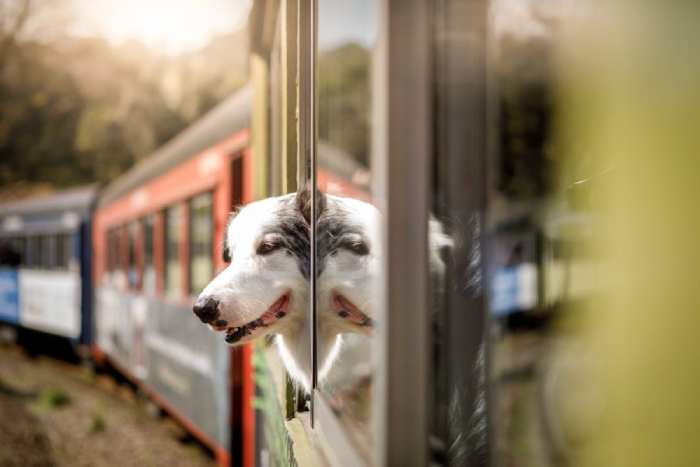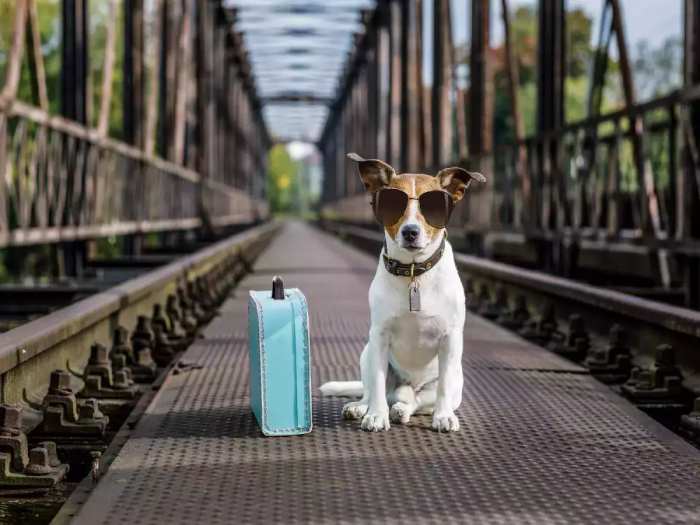Are Dogs Allowed on Trains? If you’re a dog owner like me, you know how important it is to have your furry friend by your side whenever possible. But have you ever wondered if dogs are allowed on trains? Well, you’re in luck because I’ll dive into this topic in this article and give you all the necessary information.
We’ll explore the rules and regulations regarding dogs on trains, including different train companies’ policies and any restrictions you should know. Whether you’re planning a weekend getaway or a long-distance journey, knowing whether your four-legged companion can join you on the train can make all the difference.
Why Dog Owners Should Consider Traveling by Train
Here are a few reasons why dog owners should consider this mode of transportation:

- Convenience: Traveling by train can be incredibly convenient for dog owners. Most train companies allow dogs on board as long as they meet certain requirements. This means you don’t have to worry about finding a pet-friendly hotel or making alternate arrangements for your dog’s care while you’re away.
- Comfort: Unlike cars, trains offer more space for both you and your dog to stretch out and relax during the journey. Many trains have designated areas or compartments where dogs can safely stay with their owners, making the experience more comfortable for both of you.
- Reduced Stress: Traveling can be stressful for dogs, especially when confined to a carrier or a small space. Trains generally offer a more relaxed environment than planes or crowded vehicles, reducing the stress and anxiety your dog may experience during the trip.
- Scenic Routes: Train journeys often take you through scenic routes, allowing you and your dog to enjoy picturesque landscapes together. It’s a great opportunity for bonding and creating memorable experiences.
- Environmentally Friendly: Opting for train travel over other modes of transportation is a more environmentally friendly choice. Trains produce fewer emissions than cars or planes, making it a sustainable option for eco-conscious dog owners.
Remember, before planning your trip, always check the rules and regulations of the train company you’ll be traveling with. Some companies may restrict the size or breed of dogs allowed on board or require them to remain in a carrier throughout the journey.
Read More: Are Dogs Allowed on Planes?
Benefits of Traveling with Dogs on Trains:
Traveling with dogs on trains can be a fantastic experience for both dog owners and their four-legged friends. Here are some of the top benefits of bringing your dog along on your train journey:
1. Convenience and Comfort:
When you travel with your dog on a train, you’ll enjoy the convenience of having your furry companion by your side throughout the journey. Unlike air travel, there’s no need to worry about finding a pet-friendly airline or dealing with the stress of being separated from your dog. Instead, you can relax and enjoy the trip together.
Trains also offer a comfortable and spacious environment for your dog. Most train companies have designated areas where dogs can travel with their owners, providing ample room for your dog to stretch out and relax.
2. Reduced Stress:
Traveling can be stressful for dogs, especially when they are placed in unfamiliar environments or separated from their owners. However, traveling by train can help minimize stress and anxiety for your furry friend.
The familiar presence of their owner, combined with the soothing rhythm of train travel, can help calm your dog and make the journey more enjoyable for them. Additionally, the absence of the loud noises and turbulence often found in air travel can further help reduce stress levels.
3. Scenic Routes and Exploration:
One of the greatest advantages of traveling with your dog on a train is exploring scenic routes together. Trains often traverse picturesque landscapes and offer stunning views of mountains, forests, and oceans. Sharing these breathtaking experiences with your dog can create unforgettable memories for both of you.
4. Environmental Friendliness:
Traveling by train is an environmentally friendly choice compared to other forms of transportation, such as cars or planes. Trains have a lower carbon footprint, contributing less to air pollution and greenhouse gas emissions. By opting for train travel with your dog, you are helping to reduce your carbon footprint and supporting sustainable transportation options.
Overview of Train Companies’ Policies on Dogs:
As a dog owner and travel enthusiast, I understand the importance of knowing the policies of train companies when it comes to bringing your furry friend along. Before planning your next train adventure with your dog, it’s crucial to familiarize yourself with the rules and regulations of the specific train company you’ll be traveling with.

- Amtrak: Amtrak allows dogs weighing up to 20 pounds (9 kg) to travel with their owners in carriers for a fee. Dogs are generally not allowed in sleeping cars, business class, or food service cars. However, there are some exceptions for service animals.
- Eurostar: Eurostar permits only certified assistance dogs to travel with their owners on their trains. Other dogs, even those in carriers, are not allowed on Eurostar trains.
- SNCF: SNCF, the French national railway company, allows small dogs in carriers to travel for free aboard their trains. However, larger dogs need to have a ticket and be muzzled.
- Deutsche Bahn: the German railway company, Deutsche Bahn welcomes dogs aboard their trains. However, it’s important to note that dogs must be leashed and muzzled on regional trains, while they can travel without a muzzle on long-distance trains.
- Virgin Trains: Virgin Trains in the UK allows well-behaved dogs to travel with their owners for free. Dogs must be kept on a leash at all times and are not allowed in food service areas.
Dog Size and Breed Restrictions on Trains:
When it comes to traveling with dogs on trains, it’s important to be aware of any size and breed restrictions that may be in place. While many train companies welcome dogs on board, there are often policies in place to ensure the safety and comfort of all passengers.
- Size restrictions: Some train companies have specific size limits for dogs that can travel with their owners. These restrictions are typically based on the dog’s weight or height. For example, Amtrak allows small dogs weighing up to 20 pounds to travel in carriers that fit comfortably under the seat. Eurostar permits dogs to be carried in a bag measuring no more than 16x12x8 inches.
- Breed restrictions: While most train companies do not have breed-specific restrictions, confirming whether any such restrictions exist before booking your ticket is important. Some train companies may have policies prohibiting certain breeds known to be aggressive or prone to causing disturbances. For example, Deutsche Bahn has restrictions on potentially dangerous breeds, such as Pit Bulls and Staffordshire Terriers.
It’s crucial to check the specific rules and regulations of the train company you’ll be traveling with, as policies can vary. This will help you determine whether your dog meets the size and breed requirements for a smooth and hassle-free journey. If your dog exceeds the size or breed restrictions, you may need to make alternative arrangements for their travel or choose a different mode of transportation.
By familiarizing yourself with the size and breed restrictions of the train company you plan to travel with, you can ensure that you and your furry companion have a pleasant experience on your train journey.
Guidelines for Traveling with Dogs on Trains:
When traveling with our furry friends, it’s important to know the guidelines and policies that train companies have in place. Here are some guidelines to keep in mind when traveling with your dog on a train:
- Size restrictions: Train companies often have size restrictions for dogs traveling with their owners. For example, Amtrak allows small dogs weighing up to 20 pounds to travel in carriers that fit under the seat. It’s essential to check the specific weight and size restrictions of the train company you plan to travel with to ensure your dog can be accommodated.
- Breed restrictions: In some cases, train companies may have breed restrictions. This is typically done to ensure passengers’ safety and prevent incidents. For example, Deutsche Bahn prohibits certain breeds known as aggressive from traveling on their trains. Check if any breed restrictions apply to your dog before planning your journey.
- Pet carrier requirements: Most train companies require dogs to be transported in carriers or crates. These carriers should be secure, well-ventilated, and sturdy enough to ensure your dog’s safety throughout the journey. Be sure to check the specific requirements and dimensions for pet carriers set by the train company to avoid any last-minute issues.
- Booking in advance: It’s important to book your dog’s spot on the train in advance. Many train companies have limited spaces available for pets, so it’s best to secure your dog’s spot early to avoid any disappointment or inconvenience. Some train companies may also have additional fees for traveling with pets, so check the booking guidelines and pricing.
Conclusion:
Traveling with dogs on trains requires careful planning and adherence to the rules and policies set by train companies. By familiarizing yourself with these guidelines, you can ensure a stress-free journey for both you and your furry companion.
Size restrictions play a crucial role in determining whether your dog can accompany you on the train. Train companies often have specific size limits to ensure the comfort and safety of all passengers. It’s essential to check these restrictions beforehand to avoid any last-minute surprises.
Breed restrictions may also be in place to ensure the well-being of all passengers. Some breeds may be prohibited due to their size, temperament, or potential allergies. Researching these restrictions in advance will help you make informed decisions and avoid any disappointments.
Pet carrier requirements are another important consideration. Train companies may require dogs to be transported in secure carriers that meet certain specifications. Investing in a suitable carrier will not only keep your dog safe but also make the journey more comfortable for them.
Lastly, it’s crucial to book your dog’s ticket in advance. Train companies often have limited spaces available for pets, so securing a spot early will ensure that you and your furry friend can travel together smoothly.
By following these guidelines and being a responsible pet owner, you can enjoy the convenience of traveling with your dog on trains while respecting the comfort and safety of fellow passengers. Happy travels!
Frequently Asked Questions:
Yes, most train companies allow dogs on board. However, it’s important to check with the specific train company beforehand to ensure they have policies and regulations for traveling with dogs.
Yes, there are usually size restrictions for dogs traveling on trains. Different companies have different guidelines, so it’s essential to check with the train company for their specific size restrictions before planning your trip.
Some train companies may have breed restrictions in place. It’s important to verify with the train company if they have any limitations or special requirements for certain dog breeds before making any travel arrangements.
Yes, most train companies require dogs to be in a pet carrier during the journey. It’s important to ensure that the carrier meets the company’s requirements, such as being of appropriate size and securely closed, to ensure the safety and comfort of your dog.
Yes, booking in advance is highly recommended when traveling with your dog on a train. Train companies often have a limited number of spots available for pets, so booking early guarantees that there will be space for your furry friend.

Hey there, I’m Janet Brooks, a dog-loving student from California. I’m all about helping pups in need, especially those without homes. Me and my awesome friends work together to give shelter and love to stray dogs. Oh, and I also write blogs about dogs to share helpful info.